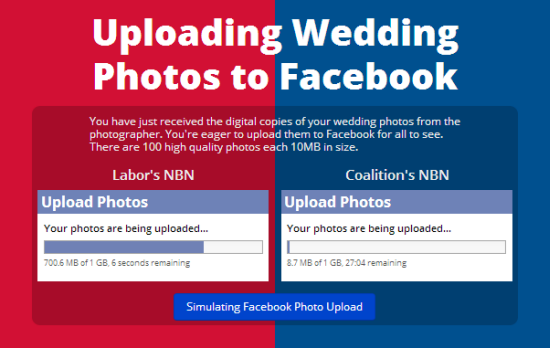The instantly popular How Fast is the NBN website, which purports to compare the speeds available from Labor’s National Broadband Network with the Coalition’s alternative broadband plan, is at least moderately misleading on at least two counts. And by focusing solely on speed it completely misses something else important: the differing political rationales that have led to those speed differences.
The key problem with the website is that Labor’s NBN is portrayed as delivering 1000 megabits per second, or Mbps (i.e. 1 Gbps), download speeds and 400 Mbps upload (a pair of speeds usually shown, as it is on the site, as 1000/400 Mbps). This is contrasted with the Coalition’s 25 Mbps down and 5 Mbps upload. That comparison is unfair and misleading.
The website has gone viral on social media. It was designed by James Brotchie, who says he is a Liberal voter with nothing to do with the ALP.
Currently the NBN’s highest-speed product on their fibre to the premises (FTTP) network is only a tenth as fast, 100/40 Mbps — although the gigabit product will be on offer in December this year.
Conversely, citing a 25/5 Mbps speed for the Coalition’s fibre to the node (FTTN) network is to use their initial minimum-speed benchmark. Coalition policy is to have, eventually, a minimum 50 Mbps download speed, with no stated guaranteed minimum upload speed. Given that the policy is to build upon a variety of technologies, some tech choices have the potential to deliver more. Upgrading the hybrid fibre-coax (HFC) system used for cable TV, for example, can deliver download speeds of up to around 300 Mbps, although that’s shared with other users of the cable segment — and is obviously only an option in areas that already have HFC.
And it’s not as if the Coalition’s NBN will ban the use of FTTP, although it’ll only be funded by their broadband plan in a minority of locations, such as greenfield housing developments, not the 93% of premises under Labor’s plan.
So to be fair, How Fast is the NBN should compare like with like. That means choosing your point in time for the comparison. If it’s today, then the Labor side should be a tenth the speed as the website shows, and the elapsed time figures 10 times as long — assuming that the Coalition’s version can be considered to exist today. But if it’s, say, a year or two from now, then leave the Labor side at 1000/400, and increase the speeds on the Coalition side to twice or four times what they are now.
The site’s calculations themselves are correct, at least inasmuch as they show the theoretical best data transfer rates that can be obtained from a link of a particular speed. Calculating that it’d take around 20 seconds to upload 1 GB of wedding photos over a 400 Mbps data link, to choose the first example, is basic arithmetic.*
But it’s misleading to think you’d get quite those speeds in the real world. As the Coalition’s Malcolm Turnbull blogged yesterday:
“Download and upload rates depend on many factors — line speed between the premise and exchange, line speed and contention further up in the network, the server at the other end of the transaction — and is always limited by the slowest link along the overall path from point A to point B. Test this yourself. Check your theoretical speed and then see if you can download a song or TV show at that speed. There are many variables at play, which explains why Netflix movies in the US download at about the same rate regardless of the nature of the connection — fibre, HFC cable, ADSL — into the customer’s premises.”
Turnbull is right, of course. And he’s right about many other things in that blog post: about how much can be done with 25 Mbps; about the cost factors involved in NBN wholesale connections; about the increasing asymmetry of data usage (at least for now); and about off-hand comments by Tony Abbott not being actual Coalition policy.
He’s right, too, in saying that many of the NBN’s fans, as he patronisingly calls them, haven’t bothered to read and address the arguments put forward by the Coalition, either in last month’s background paper or yesterday’s blog post. Indeed, one commenter called the post “an epic tl;dr”. Too long; didn’t read. Another, “Wall of text, no content”. And yet they get to vote.
As I wrote last time, central to the Coalition’s policy is the idea that the needs of the few don’t justify the more expensive and slower-to-deploy infrastructure of FTTP for everyone when it’d be quicker to do a FTTN rollout and get at least some improvement sooner for more people. Anyone who needs more speed sooner can pay for it. But will that argument cut through? I thought it would. But it seems that fans are only seeing sentences like this one from Turnbull’s blog post:
“We have clearly stated NBN Co will be asked to increase download date rates to at least 50 megabits per second across at least 90 per cent of the fixed line footprint by 2019, two terms of Parliament from now.”
Labor’s plan gives them a potential 1 Gbps from the day the fibre is connected, and they don’t seem to be noticing, or caring about, the difference in timing or cost.
*One gigabyte (1 GB) of data to transfer is eight gigabits (8 Gb), which is 8192 megabits. Divide that by 400 megabits per second, the speed of the data link, and you get 20.48 seconds









Unfortunately Turnbull’s plan is an election cycle too late. Had the Howard Government started implementing it the electorate would have accepted it and had Rudd proposed fibre to the home it would have been considered extravagant. But the Howard Government buggerised for so long with various patches of the market ‘solution’ that Turnbull’s plan seems another Coalition compromise.
[But will that argument cut through?]
No it won’t. The whole copper network will need to be replaced in the near future. Why not do it properly now with fibre.
I don’t see what the problem with the “Wall of text, no content” comment is. I thought that was a rather succinct summation of the document.
The main problem I have the the coalitions NBN strategy is that it’s a patchwork approach full of bottlenecks. Tony Windsor had it right at the last election when he said “You do it once, you do it right”. The coalition’s approach is like building a super-fast railway into Melbourne and then having only a single turnstile exit leading out of the train station. At least they have now moved on from their initial flat-out opposition or using microwave links after realising that the NBN is actually one of the few popular Labor policies.
My main problem with that “How fast is the NBN” web site is that its main examples make it sound like “how quickly can you view cat videos on youtube”. For me the biggest immediate benefits are that it allows me to work from anywhere and that I can set up proper disaster recovery for my work. We have production sites in every state. I would like to be able to set up each site to be able to take over production in case disaster strikes on site. We already do that to a degree but the sheer volume of data we need to process daily makes this impossible to do right now.
You use the word “misleading” a number of times in this article in support of Turnbull’s view point. I would suggest being misleading is a key element in the LNP’s campaign strategy against Labor & supported by the media, so if they can’t take it they shouldn’t dish it out.
I have a question for you, why do audoi/visual components have a AV (copper) cable connection option & a separate fibre optic connection. Well, that’s probably because one is a hell of a lot better than the other.
I think the examples offered on the site were spot on in terms of making a point, that’s the future we’re in for, along with important applications as Saugoof notes. A lot less childish than the chicken add.
The website is probably pretty misleading – not least because it focuses upon a *single download*.
The usage of internet in any particular household at the moment is not the “one computer in the office” that it used to be 5-10 years ago. Most housholds will have a home computer, a kid on a laptop, and two or three smartphones all accessing the internet. Smartphones outsold dumbphones in the global market for the first time last fiscal quarter – which ought to point to the fact that this scenario is only going to become more common.
Thinking of the internet as something which plugs in to the back of a grey box, and measuring what is necessary on the basis of a single-user-per-household scenario is laughable.
The whole point of large-scale infrastructure investment is to look into future usage. Economies will sink or float in the 21st century on the basis of the quality of their internet – because the internet will be *everything* – including phones. It’s not a matter of “who needs it now” it’s a matter of everyone having access to a core, essential public utility which will be the heart of commerce, education, communications, media, entertainment, research, medicine and pretty well everything else within 10 years.
Sometimes, you just have to spend the money, because putting in a half-assed solution, and then realising too late that we can’t keep up is going to cost our country dearly.